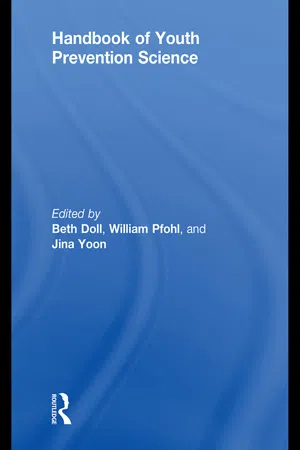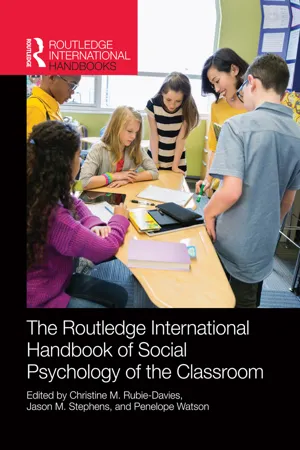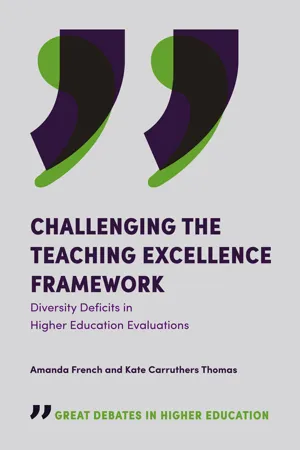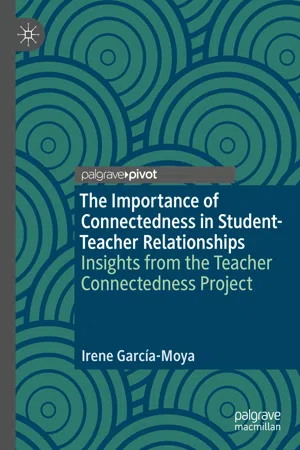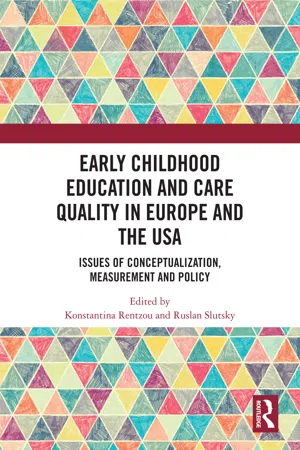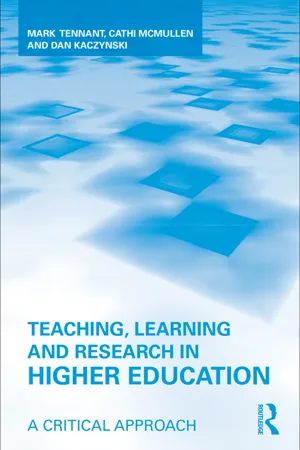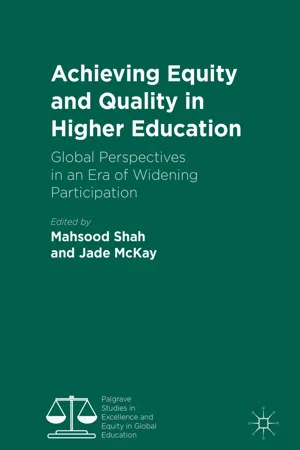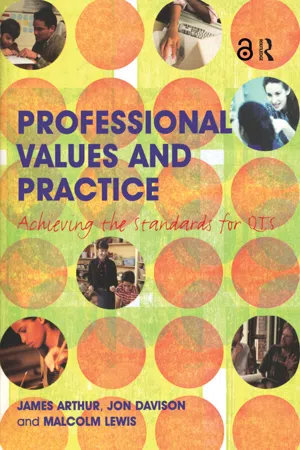Social Sciences
Teacher Student Relationships
Teacher-student relationships refer to the interactions and connections between educators and their students. These relationships can impact students' academic performance, motivation, and overall well-being. Positive teacher-student relationships are characterized by trust, respect, and effective communication, and they can contribute to a supportive and conducive learning environment.
Written by Perlego with AI-assistance
Related key terms
Related key terms
1 of 4
Related key terms
1 of 3
10 Key excerpts on "Teacher Student Relationships"
- eBook - ePub
- Beth Doll, William Pfohl, Jina S. Yoon(Authors)
- 2012(Publication Date)
- Routledge(Publisher)
Given the importance of classroom social relationships to social and academic outcomes, it is important to identify interventions that promote supportive relationships between teachers and students and among students. Such efforts are most likely to be successful when based on a good understanding of the dimensions of social relationships in a classroom and the processes by which they impact student motivation and learning. Therefore, this chapter first provides an integrative summary of the literature on the links between classroom social relationships and students’ academic and social competencies before critically reviewing research on the efficacy of interventions that attempt to promote supportive, positive classroom relationships. We begin our summary of the empirical literature on classroom social relationships with teacher–student relationships before addressing peer relationships and, finally, the overall social-emotional climate.Teacher–Student Relationships and School Adjustment
An extensive research documents links between the quality of students’ relationships with their teachers and children’s concurrent and future academic and social outcomes (for review see Hamre & Pianta, 2006; Pianta, 1999). Children who experience supportive, positive relationships with their teachers have more positive attitudes toward school (Ryan Stiller, & Lynch, 1994), are more academically engaged and achieve more (Hughes & Kwok, 2007; Hughes et al., 2008; Skinner, Zimmer-Gembeck, & Connell, 1998), enjoy higher levels of peer acceptance (Hughes, Cavell, & Willson, 2001; Hughes & Kwok, 2006), and are less likely to engage in substance abuse, early sex, and other risky behaviors (Resnick et al., 1997). Conversely, students whose relationships with teachers are characterized by conflict are more likely to drop out of school, be retained in grade, experience peer rejection, and increase externalizing behaviors (Ladd, Birch, & Buhs, 1999; Pianta, Steinberg, & Rollins, 1995; Silver, Measelle, Armstrong, & Essex, 2005). Importantly, the association between teacher–student relationship quality and subsequent adjustment holds when previous levels of adjustment are statistically controlled (Ladd et al., 1999; Hughes, Cavell, & Jackson, 1999; Hughes & Kwok, 2006; Hughes et al., 2008; Meehan, Hughes, & Cavell, 2003). - Christine M. Rubie-Davies, Jason M. Stephens, Penelope Watson, Christine M. Rubie-Davies, Jason M. Stephens, Penelope Watson(Authors)
- 2015(Publication Date)
- Routledge(Publisher)
Educational Psychologist , 34: 59–69.Wentzel, K.R., Battle, A., Russell, S.L. and Looney, L. (2010) ‘Social supports from teachers and peers as predictors of academic and social motivation’, Contemporary Educational Psychology , 35: 193–202.Wilcken, A.J. (2013) ‘The role of relationship quality and relatedness to teachers in engagement and achievement in elementary and middle school: a longitudinal study’, doctoral dissertation, available from MSU Library, Order Number 97813030600451303060043.Wu, J.Y., Hughes, J.N., and Kwok, O.M. (2010) ‘Teacher–student relationship quality type in elementary grades: effects on trajectories for achievement and engagement’, Journal of School Psychology , 48: 357–387.Passage contains an image
17Student–Teacher Relationships at the Tertiary Level
Prevailing perspectives, existing research, and future possibilities Mohamed AlansariOften researchers talk about student–teacher relationships, or classroom relationships, as an integral part of the learning process. Relationships between students and their teachers have been shown to have a large effect on student achievement (Cohen’s d = 0.72, Hattie 2012), and have become a focal point of educational research in the past few decades. Investigating classroom relationships is predicated on the premises that: (1) relationships are foundational to the classroom environment (Babad 2009); (2) these relationships can be conceptualized and measured against student outcomes (Hattie 2009; Moos 1979); and (3), fostering relationships could have a positive influence on student cognitive and affective outcomes at all education levels (Cornelius-White 2007; Kek and Huijser 2011).Despite the belief that student–teacher relationships are important at all education levels (primary, secondary, or tertiary), there is a lack of empirical studies investigating these relationships at the post-secondary level. The lack of such studies is evident in a number of handbooks and literature reviews (Fraser et al. 2012; Freiberg 1999), where studies investigating classroom relationships at the tertiary level were outnumbered by studies investigating classroom relationships at the pre-tertiary level. One possible explanation for the relative void of research may be the difficulty associated with conceptualizing and measuring what constitutes a relationship- eBook - ePub
Challenging the Teaching Excellence Framework
Diversity Deficits in Higher Education Evaluations
- Amanda French, Kate Carruthers Thomas, Amanda French, Kate Carruthers Thomas(Authors)
- 2020(Publication Date)
- Emerald Publishing Limited(Publisher)
Hunt, 2017 , p. 2), and should lead to a more nuanced understanding and experience of excellent teaching.Student–teacher rapport/relationships are central to effective learning (hooks, 2010 ; Hunt, 2017 ; Shaw, 2017 ).1Interpersonal relations within a learning community (student-to-student, student-to-teacher, teacher-to-teacher) create an inclusive, productive learning environment and foster for students a sense of belonging understood to affect retention, success and wellbeing (Haughton & Anderson, 2017 ; Thomas, 2012 ). This is particularly important for widening participation students who often experience alienation (Thomas, 2012 ) and black, Asian and ethnic minority students who may feel ‘out of place’ (Bhopal, 2018 , p. 92).Student Perspectives on Teaching Excellence: Rapport
The research that informs this paper tells us student–teacher rapport can significantly influence a student's learning experience and outcomes (Wilson, Ryan, & Pugh, 2010 ). A recent study of student perception of teaching excellence found students place the relationship with their teacher over academic content (Lammers, Gillaspy, & Hancock, 2017 ). Rapport, in this sense, has been defined as ‘interaction with components of friendliness and care (Altman, 1990 )’ (Hunt, 2017 , p. 2), and is central to the initial development of any relationship (Smith, 2015 ). Vygotsky claimed that learning is enhanced by student–teacher connection, where deep learning is experienced as a collaborative journey (Clapper, 2015 ). However, teaching excellence as it is measured in the metrics that inform TEF does not capture the importance of the learning relationships understood as central to a positive learning experience (Wood & O'Leary, 2019 - eBook - ePub
The Importance of Connectedness in Student-Teacher Relationships
Insights from the Teacher Connectedness Project
- Irene García-Moya(Author)
- 2020(Publication Date)
- Palgrave Pivot(Publisher)
2005 ).Classrooms are unique developmental contexts for children, with teachers influencing students’ academic, social, and emotional development. As Hamre and Pianta (2010 ) have rightly observed, educational research has tended to approach the study of classrooms from an instructional point of view, whereas developmental science has mainly focused on the social processes operating in classroom dynamics. Nevertheless, what both educational and developmental researchers have in common is that they see student-teacher relationships as an essential element to understanding classroom and school experiences and their contribution to students’ positive development.This section provides an overview of the contributions of student-teacher relationships to wellbeing in schools, offering both a theoretical and an empirical perspective on this topic.2.1 Student-Teacher Relationships and Wellbeing Through a Theoretical Lens
Numerous theories can help us understand why student-teacher relationships are important for students’ development and wellbeing (Davis, 2003 ; Wentzel, 2010 ). These theories focus on where the importance of student-teacher relationship stems from and on the defining features of high-quality student-teacher relationships. Table 1.1 provides an at-a-glance summary of the main theoretical approaches in the study of student-teacher relationships that are presented in the remainder of this section.Table 1.1 Main theoretical approaches in the study of student-teacher relationshipsTheoretical approach Dimensions used to characterise student-teacher relationships Examples of studies Attachment theory Closeness, conflict, and dependency Baker, Grant, & Morlock 2008 ; Koomen & Jellesma, 2015Parenting style theory Responsiveness/nurturance and demandingness/control - eBook - ePub
Early Childhood Education and Care Quality in Europe and the USA
Issues of Conceptualization, Measurement and Policy
- Konstantina Rentzou, Ruslan Slutsky(Authors)
- 2020(Publication Date)
- Routledge(Publisher)
Teacher–child relationships make all the difference: constructing quality interactions in early childhood settingsShelley McNally and Ruslan SlutskyABSTRACT
High-quality teacher–child relationships provide protective and supportive environments that provide social support for children to engage in curriculum and take risks that result in overall school success (Buyse, Verschueren, & Doumen, 2011; Pianta & Stuhlman, 2004). Teachers have the potential to use their relationship as a tool for helping children succeed in school (Birch & Ladd, 1997). Through training and awareness of specific beliefs, teachers would be more informed about what to focus on as they attempt to establish relationships with young children that support cognitive and emotional development, self-regulation, and school adjustment and social skills. Children, especially those at risk for developing poor-quality relationships with teachers, could benefit as teachers become more aware of the important connection between positive emotional climate and academic success.Introduction
The years between one and five are critical to a child’s cognitive, physical, and emotional development and the types of interactions children encounter with caregivers have a significant influence on how they develop. In this paper, we will discuss teacher beliefs about relationships and relationship quality, and how those beliefs aligned with the practice of four preschool teachers.Young children exist and develop within a complex system of relationships that are inter-related and interdependent (Bronfenbrenner, 1986; Malaguzzi, 1998). Beginning with immediate family members, especially the primary caregiver, children’s relationships gradually expand to include extended family members, cultural experiences, and school environments (Bronfenbrenner, 1986; O’Connor & McCartney, 2007; Swick & Williams, 2006). It is within this complex system of relationships that children experience interactions with others that determine their level of trust and sense that they can rely on adults to provide for them what they need. - eBook - ePub
Teaching, Learning and Research in Higher Education
A Critical Approach
- Mark Tennant, Cathi McMullen, Dan Kaczynski(Authors)
- 2009(Publication Date)
- Routledge(Publisher)
CHAPTER 4Framing Teacher–Learner RelationshipsIntroduction
Teacher–learner relationships are at the heart of teaching practice. Yet these relationships often remain unexamined. Continuing the theme of reflexive engagement, we explore in this chapter the influence of teachers’ own educational experiences in framing teacher–learner relationships and the variety of ways in which teachers position themselves or are positioned in relation to their students. To add life to this discussion and give a sense of the emotions encountered in teaching, particularly in the early days, we draw on the experiences of award winning teachers who narrated their teaching life stories in a recent study conducted by one of the authors (McMullen, 2008).We take the view that teaching practice involves much more than mastery of technical skills. It has a moral and relational dimension as highlighted by Noddings (2003), ‘We affect the lives of our students not just in what we teach them by way of subject matter but how we relate to them as persons’ (p. 249). There is nothing new in the suggestion that good teachers understand the need for caring relationships with their students. Carl Rogers in Freedom to learn (1983) highlights the role of relationships in creating a climate that enhances natural potentiality and desire for learning.The facilitation of significant learning rests upon certain attitudinal qualities which exist in the personal relationship between the facilitator and learner … Here is a vital person, with conviction, with feelings … She doesn’t fit into some neat educational formula. She is, and students grow by being in contact with someone who really and openly is. (pp. 106–107)However, given the intensification of work in contemporary universities there is a need for greater examination of the ways in which university teachers negotiate the multiple obligations they face and the emotional work involved in this negotiation process. Are the idealised relationships promoted by Rogers possible in today’s higher education setting? As part of their relationships with students, teachers need to be aware themselves, and make their students aware, of the broader context within which their relationship takes place. - eBook - ePub
Achieving Equity and Quality in Higher Education
Global Perspectives in an Era of Widening Participation
- Mahsood Shah, Jade McKay, Mahsood Shah, Jade McKay(Authors)
- 2018(Publication Date)
- Palgrave Macmillan(Publisher)
Murphy (2009) highlights that social relationships encourage a student in their transition to becoming a ‘fish in water’ as academic relationships support students’ academic and social integration into higher education. This is a notion that is also promoted by phase one of the What Works? Programme, which not only stresses the importance of the learning relationship in student success, but also recognizes the importance of building early and good social relationships with other students and staff (Thomas 2012). This is important because it not only supports transition but also promotes the perception of caring and reliable support which is crucial in underpinning pedagogical strategies that create a safe educational setting to stimulate and challenge students. Field and Morgan-Klein (2012) note that staff and student relationships provide both practical support and symbolic value, as they foster intellectual development and encourage a sense of belonging in higher education. Access to learning relationships might be hampered for some groups of students, which reduces their opportunities to be successful (Cousin and Cureton 2012). One of these barriers is students’ fear of stereotype threat. This is the students’ fear that the lecturer may apply a stereotype to them that is based on appearance and that they may behave according to the beliefs they hold about the stereotype, rather than from what they know about the individual (Cousin and Cureton 2012). This is partially supported by Frumkin and Koutsoubou (2013) who found that BME students in further education reported that if teaching staff demonstrated that they were knowledgeable about a student’s culture it led to them feeling an increased sense of inclusion. Cousin and Cureton (2012) reported that both lecturers and students highlighted that good learning relationships are crucial to student success - eBook - ePub
- Irving B. Weiner, William M. Reynolds, Gloria E. Miller(Authors)
- 2012(Publication Date)
- Wiley(Publisher)
For instance, in early childhood, it may be useful to assess teacher- and child-perceptions of closeness, as well as observe relationships between dyads. Some preliminary work in this area demonstrates the potential for multiple perspectives (e.g., Koepke & Harkins, 2008; Mantzicopoulos & Neuharth-Pritchett, 2003), but further research is needed on source effects and the robustness of findings across multiple informants. 4. Although the studies from the previous decade have begun to uncover how relationships with teachers are related to development, past studies tend to be limited by their methods and design, mostly using non-experimental data. Because children are not randomly assigned into classrooms, future studies should use designs to control for the selection of children into certain classrooms. 5. There is a need to expand beyond the dyadic paradigm and intervene across multiple levels within the developmental system, including community, classroom, family, and individual contexts. Clearly delineating and disseminating the school-, classroom-, and individual-level practices and structures associated with closer relationships between teachers and students would aid educators in promoting positive outcomes, particularly for at-risk children, and aid in teacher professional development. 6. The reciprocal interactions between teachers and children are embedded within a complex system including proximal factors such as families and peers, and more distal features such as schools, communities, and cultures (Good & Weinstein, 1986; Pianta, 1999; Pianta et al., 2003). To date, ecological studies have explored how multiple systems interact and influence relationships; however, these studies often omit sociocultural influences. Recent international work suggests that student-teacher relationships may operate differently depending on the cultural context (e.g., Fredriksen & Rhodes, 2004; Joshi, 2009) - eBook - ePub
Professional Values and Practice
Achieving the Standards for QTS
- James Arthur, Jon Davison, Malcolm Lewis(Authors)
- 2005(Publication Date)
- Routledge(Publisher)
6 Professional Relationships with Colleagues
Working successfully with colleagues is essential in any occupation. Good professional relationships have both organisational and personal dimensions. Productive working relationships are important for carrying out whatever organisational tasks need collaboration with others, but effective interactions at work are also very important contexts in which individual members of organisations satisfy basic personal, social and emotional needs.Successful professional relationships have always been at the heart of the work of schools and teachers. It is no surprise that schools have increasingly sought to achieve the Investors in People Standard as a declaration of commitment to good practice in this area and as they seek to develop themselves as professional communities. Recent policy developments have placed new emphasis on teachers working with others in schools. The GTCE’s Code of professional practice includes expectations which give teachers’ work with others a certain kind of professional status. The government’s policies for ‘remodelling the workforce’ (DfES, 2002a, b) are involving teachers in adjusting to two significant developments regarding those with whom they have routine interactions in school. The first is a planned increase in the numbers of Teaching Assistants (TAs) and the introduction of a new category of ‘Higher Level Teaching Assistants’, which will mean that more teachers than before will be working with more support in more classrooms. The second is represented by changes to teachers’ conditions of service which are intended to pass to other people in schools a range of tasks and responsibilities which teachers have hitherto carried out themselves (DfES, 2003). Together, these developments significantly redraw the formal map of professional relationships in schools. More generally, policy trends over the last few years have increased the emphasis schools have to place on various forms of partnership and collaboration (Hargreaves, 1994; Helsby, 1999; Furlong et al., - eBook - ePub
Teachers, Teaching, and Reform
Perspectives on Efforts to Improve Educational Outcomes
- Ralph P. Ferretti, James Hiebert(Authors)
- 2017(Publication Date)
- Routledge(Publisher)
policy in education (e.g., accountability, regulation of teacher preparation) could recognize teacher-child interactions as a unique and powerful resource for student achievement and development. In essence, this is a recommendation to focus policy and regulation aimed to improve teacher effectiveness on classroom processes more proximal to teaching and student learning rather than on distal factors such as teachers’ degrees or outputs such as student test scores. As schools have ramped up academic demands and focused on state standards assessed using group-based multiple-choice tests, an argument can be made that the first wave of school reform efforts has not created developmentally salient opportunities for learning or teaching. As economic stresses have been placed on students, families, and communities over the past decade, the risks associated with poverty have interacted with, and exacerbated, these school-based demands. Students and teachers report increasing levels of stress (NCES, 2014) and rates of teachers’ use of exclusionary discipline practices (e.g., suspension) have increased dramatically over the past decade, a trend that has been characterized as reflecting notable misalignment between demands on students and educators and resources that are relevant for their success (Sullivan & Bal, 2013). Fifty percent of the teaching workforce leaves the profession after five years (Greenberg, Pomerance, & Walsh, 2011; NEA, 2010), with the vast majority reporting feeling inadequately trained to respond effectively to students’ social needs and behaviors. And by some indications, more than 10% of schools in the United States are chronically failing to engage students in productive learning opportunities (NCES, 2014). In this context, a policy focus on teacher-student interactions as a key marker for teaching and learning could spur activity that fosters improved educational opportunity and outcomes.Recognition of the value of teacher-student interactions could take shape in policies that enable regular gathering of population-level data on the nature and quality of interactions in U.S. classrooms. The Office of Head Start (2011) has led in the use of standardized observation of classrooms through its Designation and Renewal System of assessment and accountability, yielding data informing how to target professional development. Teacher-student interactions could also be made visible in policies related to the regulation of teacher preparation programs. At the federal level, this takes place through Title II of the Higher Education Act, which has called for assessment of teacher candidates’ effectiveness in the classroom as a metric for preparation program accountability. Although the suggested policies have too often relied on the use of student achievement tests as these assessments (resisted strongly by teacher preparation both on political and logistic grounds), recent policy formulations include standardized observations of interaction as one indicator of teacher candidate effectiveness.
Index pages curate the most relevant extracts from our library of academic textbooks. They’ve been created using an in-house natural language model (NLM), each adding context and meaning to key research topics.
Explore more topic indexes
Explore more topic indexes
1 of 6
Explore more topic indexes
1 of 4
